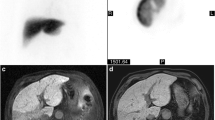Abstract
To determine whether the scintigraphic evaluation of technetium-99m diisopropyl iminodiacetic acid (DISIDA) uptake and excretion can distinguish among liver transplant patients with biopsy evidence for rejection, cholestasis or neither condition, we reviewed scintigrams and biopsies in 36 patients. There were 76 scintigrams with corresponding biopsies. Uptake and excretion were graded from image data on scales reflecting normal through severely abnormal values. Biopsies were evaluated for findings of cholestasis and rejection. The majority of scintigrams demonstrated normal uptake (60/75, 80%) and delayed excretion (65/76, 85%), which was most marked immediately after transplantation. One-way analysis of variance showed that the mean excretion values significantly differed between patients with normal biopsies and those with cholestasis and/or rejection (P =0.0003). However, mean uptake scores demonstrated no statistically significant difference between these two groups of patients (P =0.1). These findings suggest that 99mTc-DISIDA scintigraphy can differentiate between transplants with and without rejection/cholestasis but not between rejection and cholestasis. If 99mTc-DISIDA excretion is normal, rejection and cholestasis are unlikely.
Similar content being viewed by others
References
Bauman J, Campbell WL, Demetris AJ et al. (1989) Intrahepatic cholangiographic abnormalities in liver transplants: correlation with biopsy evidence of rejection and other disorders. AIR 152:275–279
Brown RKJ, Memsic LDF, Busuttil RW et al. (1986) Accurate demonstration of hepatic infarction in liver transplant recipients. J Nucl Med 27:1428–1431
Cuervas-Mons V, Canton T, Escandón J et al. (1987) Monitoring of the rejection of intrasplenic hepatocyte allografts and xenografts in the rat using technetium 99m-imidoacetic acid scanning. Transplant Proc XIX:3850–3851
Dalen K, Ascher NL et al. (1988) Imaging vascular complications after hepatic transplantation. AIR 150:1285–1290
Davis PL, Van Thiel DH, Zajko AB et al. (1989) Imaging in hepatic transplantation. Semin Liver Dis 9:90–101
deJonge MWC, Pauwels EKJ, Hennis PJ et al. (1983) Cholescintigraphy with 99mTc-diethyl-IDA for the detection of rejection of auxiliary liver transplants in pigs. Eur J Nucl Med 8:485–488
Esquivel CO, Jaffe R, Gordon RD et al. (1985) Liver rejection and its differentiation from other causes of graft dysfunction. Semin Liver Dis 5:369–374
Hawkins RA, Hall T, Gambhir SS et al. (1988) Radionuclide evaluation of liver transplants. Semin Nucl Med 18:199–212
Klingensmith WC, Spitzer VM, Fritzberg AR et al. (1981) The normal fasting and postprandial Tc-99m-diisopropyl-IDA hepatobiliary study. Radiology 141:771–776
Krishnamurthy S, Krishnamurthy GT (1989) Tc-99m-Iminodiacetic acid organic anions: review of biokinetics and clinical applications in hepatology. Hepatology 9:139–153
Kuni CC, Engeler CM, Nakhleh R et al. (1991) Correlation of Tc-99m-DISIDA hepatobiliary studies with biopsies in liver transplant patients. J Nucl Med 32:1545–1547
Letourneau JG, Day DL, Ascher NL et al. (1987a) Abdominal sonography after hepatic transplantation: results in 36 patients. AIR 149:299–303
Letourneau JG, Day DL, Maile CW et al. (1987b) Liver allograft transplantation. Postoperative CT findings. AJR 148:1099–1103
Loberg MD et al. (1980) Letter. J Nucl Med 21:1111–1112
Loken MK, Ascher NL, Boudreau RJ et al. (1986) Scintigraphic evaluation of liver transplant function. J Nucl Med 27:452–459
Okuda H, Nunes R, Vallabhajosula S et al. (1986) Studies of hepatocellular uptake of the hepatobiliary scintiscanning agent Tc99m-DISIDA. J Hepato 13:251–259
Snover DC (1986) The pathology of acute rejection. Transplant Proc 18:123–127
Snover DC, Sibley RK, Freese DK et al. (1984) Orthotopic liver transplantation: a pathological study of 63 serial liver biopsies from 17 patients with special reference to the diagnostic features and natural history of rejection. Hepatology 4:1212
Snover DC, Freese DK, Sharp HL et al. (1987) Liver allograft rejection. An analysis of the use of biopsy in determining outcome of rejection. Am J Surg Pathol 11:1–10
Starzl TE, Iwatsuki S, Van Thiel DH et al. (1982) Evolution of liver transplantation. Hepatology 2:614–636
White RM, Zajko AB, Demetris AJ et al. (1987) Liver transplant rejection: angiographic findings in 35 patients. AJR 148:1095–1098
William JW, Vera S, Peters TG et al. (1986) Cholestatic jaundice after transplantation. Am J Surg 151:65–69
Zajko AB, Campbell WL, Bron KM et al. (1985) Cholangiography and interventional biliary radiology in adult liver transplantation. AJR 144:127–133
Author information
Authors and Affiliations
Additional information
Offprint requests to: C.M. Engeler
Rights and permissions
About this article
Cite this article
Engeler, C.M., Kuni, C.C., Nakhleh, R. et al. Liver transplant rejection and cholestasis: comparison of technetium 99m-diisopropyl iminodiacetic acid hepatobiliary imaging with liver biopsy. Eur J Nucl Med 19, 865–870 (1992). https://doi.org/10.1007/BF00168162
Received:
Revised:
Issue Date:
DOI: https://doi.org/10.1007/BF00168162




